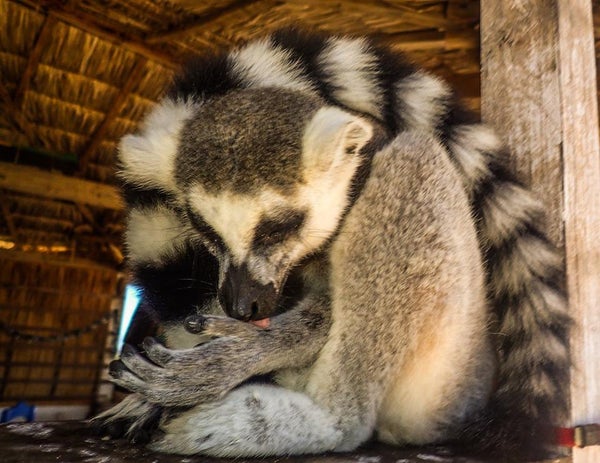This article was published in Scientific American’s former blog network and reflects the views of the author, not necessarily those of Scientific American
Some restaurant owners keep a tank of exotic fish to attract and entertain their customers. In Madagascar, patrons are more likely to see a live lemur chained to the wall.
Private ownership of lemurs is against the law in Madagascar—the only island where the primates are found—but that doesn’t stop people from snatching the animals from the wild and turning them into pets. Earlier this year American researchers estimated that home and business owners had taken 28,000 lemurs in the previous three years.
The illegal trade affects at least 30 of the 103 known lemur species, but new research reveals that one of those species—the gorgeous and iconic ring-tailed lemur (Lemur catta)—represents a huge portion of the market.
On supporting science journalism
If you're enjoying this article, consider supporting our award-winning journalism by subscribing. By purchasing a subscription you are helping to ensure the future of impactful stories about the discoveries and ideas shaping our world today.
For the past several months Kim Reuter at Temple University and Melissa Schaefer at the University of Utah have been collecting photographs from tourists who encountered lemurs in homes, restaurants, resorts and hotels. So far their Pet Lemur survey has amassed sightings of 685 pet lemurs. According to data presented this week at the International Congress for Conservation Biology an astonishing 28 percent of the animals spotted were ring-tailed lemurs.
That number “is a really, really bad sign,” says Reuter, the lead researcher on the project and one of the founders of the Lemur Conservation Network. It is especially disturbing because there are no estimates for the wild population of ring-tailed lemurs, although all indications show that they are on the decline. “I think that we need a lot more research in order to know exactly what sort of threat we're facing,” Reuter says, “though it's safe to say that the illegal pet trade could be impacting a large amount of the population.”
As you might guess, the lemurs don’t always do well in captivity. “The conditions of the lemurs in restaurants and the other settings are, on average, not great,” Reuter says. They’re often provided with foods that don’t match their natural diets and they’re often housed alone—not an ideal situation for a very social species. The lemurs are also usually kept on ropes or in small cages, leading to abnormal behavior such as repetitive pacing.
Reuter says not all owners mistreat their lemurs. “There are owners who are taking the time to provide a good environment for their pet lemurs,” she says. “I would estimate that most owners are not purposefully keeping lemurs in bad conditions. On the contrary, I think lemurs are kept in bad conditions because keeping primates in captivity is difficult and takes a lot of resources that most people, even well-intentioned people, don't have in Madagascar.”
Reuter and her colleagues will continue to gather lemur sighting reports and are now working on several policy-related documents about captive lemur ownership. “There are lots of lemurs in illegal captivity but there isn't much capacity to deal with the situation,” she says. “For example, the government is supposed to confiscate lemurs and then place them in legal captive facilities, but these facilities simply do not have the capacity to take in thousands of lemurs.” She points to one organization, Lemur Love, that is aware of dozens of animals being kept illegally but it doesn’t have the resources to rescue them.
The pet trade is just one of the many threats facing lemurs. Lisa Gould of the University of Victoria, one of the world’s preeminent ring-tailed lemur researchers, says deforestation and the bushmeat trade have been particularly hard on the species. “Most known populations, the ones where biologists have conducted research, seem to be quite isolated in forest fragments, often with no nearby fragments for male dispersal at all,” she says, adding that all known populations are smaller than 250 individuals. “Some populations consist of a few dozen or even fewer.”
In recent years conservationists have focused primarily on deforestation and hunting. Reuter says it’s time to add the pet trade to that list. “Lemur Love has a hard time competing with larger organizations for funding partly because the pet trade is still viewed as a problem that is not as important as other threats facing lemurs.” If the new research is any indication, then that blind eye toward the pet trade could be a black eye in lemur protection.
Previously in Extinction Countdown:
Crisis in Madagascar: 90 Percent of Lemur Species Are Threatened with Extinction
Diminutive, but Not Disappeared: Rare Dwarf Lemur Rediscovered 100 Years after Last Sighting
Photo courtesy of Pet Lemur Project
